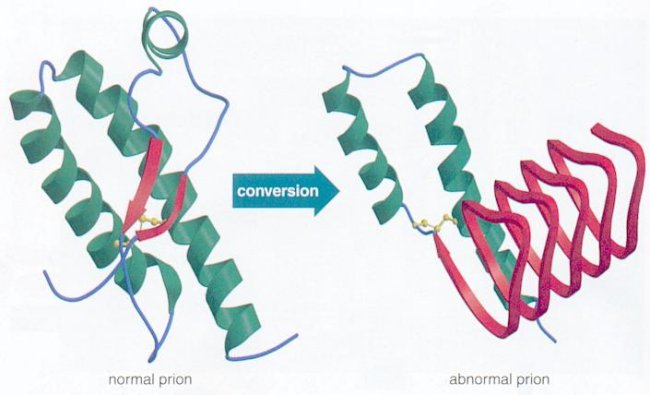Answer: A prion is a misshapen protein that may be a disease causing agent in the brain.
Normally, proteins that are synthesized from RNA have to be folded in a very specific manner to be functional. For example, ion channels and intracellular signaling molecules are proteins that must have their component amino acids in the correct order for them to function properly. Sometimes, when these proteins are misshapen, the proteins interact with each other, causing an abnormal accumulation of proteins inside the cell. These clumps of proteins, called aggregates, are believed to result in disease. For instance, in Parkinson's disease, there is an accumulation of proteins called Lewy bodies.
Some proteins that are misfolded are known to cause other proteins to also misfold. These are prions. Prions accumulate inside the cell and can also cause diseases. Prions themselves are highly resilient to destruction. They can withstand very high temperatures and extremely destructive chemicals that would normally kill other disease causing agents like bacteria or viruses.
Prions and disease
Prions are known to cause several diseases. The most well known is Mad Cow disease, or bovine spongiform encephalopathy. This disease causes bovine to behave unusually, and can be passed to humans if proper safety measures are not taken. The human form of the disease is called variant Creutzfeld-Jakob disease.
Prions can cause a nervous system disorder once prevalent among the cannibal tribes of New Zealand. The disease itself is called kuru, and results in uncontrollable shaking and weakness. It is always lethal; generally a person with kuru will die within a year of the appearance of their symptoms.
Prions are the cause of a rare hereditary disorder called fatal familial insomnia. In fatal familial insomnia, the person experiences worsening insomnia until they can no longer sleep. They eventually die from the disease. The prion protein itself accumulates and damages the thalamus, resulting in the symptoms.
Prions are also the cause of scrapie, a disease that is found in livestock animals. It has been characterized most extensively in sheep.
Currently, there are no known cures for prion diseases. Since they are almost all lethal, the only way to prevent the disease is to ensure that prions do not pass between species. Many livestock processing regulations are put into place in order to minimize the potential spread of the disease. For instance, nervous tissue has to be completely separated from the other tissue during butchering. Also, precautions are taken to ensure that livestock do not get exposed to that nervous tissue.
The structure of prions was discovered by Dr. Stanley Prusiner and described in 1982. He created the word prion, which itself was a mashup of the words “proteinaceous” and “infectious agent.” In 1997, he was awarded the Nobel Prize in Physiology or Medicine for his work on prions.
